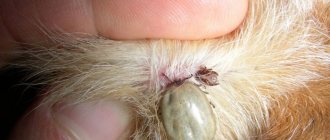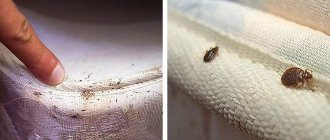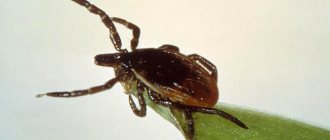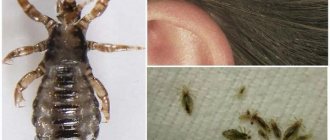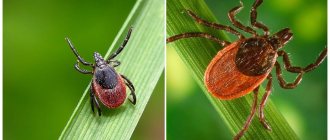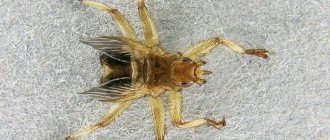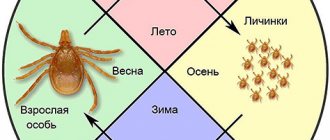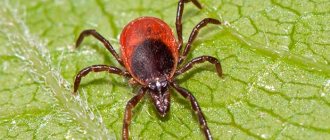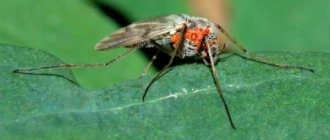Several types of mites can parasitize dogs: sarcoptoid mites (also known as scabies), Demodex Canis, which specializes exclusively on canids, as well as representatives of the ixodid family. It was the latter that got the name “dog tick”. But, despite the classification, not only pets, but also other animals and people become victims of the parasite.
Where does it live?
The dog tick is an arachnid. Latin name: Ixodes ricinus. This is a typical representative of the large Ixodid family. Also called European forest.
Parasites live in Europe, Asia, North Africa and North America. In Russia, they are widespread in the central zone, where they coexist with a related species - taiga ticks. However, warm winters are gradually expanding the distribution boundaries of Ixodes ricinus in northern latitudes.
Arachnids prefer damp areas where they can find a food source. Therefore, they are predominantly localized in mixed and deciduous forests, forest-steppes, meadows, lowlands, and near water bodies. But when there is a lack of food supply, they migrate to drier habitats. They comfortably tolerate ambient temperatures up to 30–35 °C.
Contrary to popular belief, dog ticks, like other representatives of ixods, do not live in trees and do not climb to great heights. They mainly live in grass, where it is more humid.
Habitats
Ticks are widespread throughout the countries of Eastern, Central and Northern Europe and in the northern part of China and Mongolia. The number increases annually. Ticks are exploring new and new territories. If 50-70 years ago their habitats in Russia were predominantly taiga forests, then 30-40 years ago they were observed in the forests of the south and central Russia, but today they have already populated city parks and public gardens in almost the entire European part of Russia. Bites were reported in 82 regions of Russia.
As an independent infection, tick-borne encephalitis was discovered in the Far East and studied by Soviet scientists in 1937-1939. It is possible that natural foci of this virus existed here long before the appearance of humans. There have been rumors among people for a long time that the encephalitis tick was artificially bred in Japanese laboratories in the mid-40s of the last century and launched to us in Siberia as a biological weapon. However, authoritative Russian scientists refute this version
Endemic territories of Russia for tick-borne encephalitis
Today, the habitat of ixodid ticks is located throughout the forest and forest-steppe temperate climatic zone of the Eurasian continent
Ticks are moisture-loving. Therefore, their numbers are high in well-moistened places, so they prefer moderately shaded and moist deciduous and mixed forests with dense grass and undergrowth. There are many ticks along paths in overgrown forest grass, in last year's grass and dead wood, along river banks, in forest clearings. Ixodid ticks are common mainly in forests, but also in rural areas, suburban areas, and in city parks and squares.
Diagram of tick distribution
Therefore, most infections occur outdoors. During the active phase (periods May-June and August-September), their number increases significantly.
Appearance
The description of dog ticks has much in common with other species of the ixodid family:
- hungry adults cannot boast of large dimensions. The size of females does not exceed 4 mm. Males are quite small - barely reaching 2.5 mm in length. The size of hungry nymphs is 1.3–1.5 mm. After saturation with blood, individuals increase in size by 2–3 times and outwardly look like balls. The length of well-fed females varies in the range of 11–13 mm. The photo clearly shows the differences in appearance before and after blood sucking;
- The color of arachnids also depends on the degree of satiety and age. Hungry parasites are brown. After a meal they become gray;
- The body is oval in shape, covered on the outside with a brown shield that reliably protects from external negative factors and injuries from a fall. In males it practically covers the entire dorsal part, in females it barely covers the front. The remaining integument is soft, elastic, with a large number of folds, which provides good stretching and a significant increase in the volume of the body;
- Adult ticks have 4 pairs of thin limbs equipped with growths that help the parasite crawl unhindered on various surfaces. It is by the number of legs that you can distinguish a tick from an insect. The latter has only 3 pairs;
- the head is small, devoid of mustache and full eyes. If you examine the structure of the oral apparatus under a microscope, you will notice chelicerae and protrusions on the oral proboscis, which ensure a strong fixation of the parasite while sucking blood on its victim.
Signs of infection
Symptoms of lice eaters in dogs are as follows:
- constant itching, which leads to the appearance of wounds;
- the presence of small white grains in the dog’s fur, reminiscent of dandruff (only upon careful examination can you notice their movement);
- the pet's fur loses its healthy appearance - it becomes dull, sticks together into clumps, it is even possible to remove the hair due to lice;
- The inner thighs, base of the tail and head of the dog are especially susceptible to baldness. Such areas become swollen and reddened, and may become crusty;
- lack of appetite and thirst leads to weight loss;
- Restless behavior of the dog, itching causes her insomnia.
Features of life
On average, the development of a dog tick from egg to adult lasts 2–3 years. During this period, it changes three owners. Under unfavorable conditions, the life cycle extends for 6 years.
With the onset of heat, pests leave their shelters, most often the peak of activity occurs in May-June, August-September. Females are oviparous. To lay eggs, the female must receive a portion of blood. The younger generation also needs nutrition to move to the next stage of development.
They prefer to hunt in the morning and evening, when the plants are wet with dew. Ticks do not jump or fly. They wait for their prey on the grass. Thanks to a well-developed sense of smell and thermoreceptors, a potential host can be sensed at a distance of 10–15 m.
Adults prefer large mammals:
- canids;
- horses;
- goats;
- cows, deer.
The larvae feed on smaller creatures: squirrels, voles. Nymphs choose large rodents, rabbits, foxes, birds, and wild boars. Having chosen a food source, the dog tick spends half an hour looking for a place to attach itself. The parasite's saliva has an anesthetic effect, so the victim does not feel anything. The female’s blood-sucking process can last from 1 to 5 days; young individuals feed for 1–3 days.
A dog tick can also bite a person if he does not feel the bloodsucker’s movements throughout the body.
Q fever
Q fever is an acute natural focal disease caused by Burnet's rickettsia. The disease is characterized by an acute chronic course and primary severe damage to the respiratory tract, causing first bronchitis and then pneumonia.
The photo below shows the bacteria Coxiella burnetii at high magnification:
Foci of the disease exist both in the wild (wild artiodactyls, rodents) and can be anthropourgic (the source is farm animals: cattle, sheep, pigs, horses, poultry).
The carriers are ixodid ticks, in particular the dog tick. The infected parasite, feeding on a new host, defecates to free the intestines for new portions of blood. Rickettsia also comes out with excrement. Through a wound in the skin, pathogens enter the human or animal body - this is how infection occurs.
Reproduction
Mating of dog ticks occurs on the body of the victim. Males feed for a short time, 20–30 minutes, and after fertilization of the female, they soon die. The satiated female falls to the ground and after a few days begins to lay eggs in moist soil, foliage, and forest litter. Fertility amounts to several thousand. But most of the embryos die.
The development of the eggs lasts about 3 weeks, after which small larvae up to 1 mm in length appear. Juveniles have only 3 pairs of walking legs. The larval stage lasts from 1 to 6 weeks. After feeding, the larvae molt and turn into nymphs, which outwardly look like adult ticks, but are not yet capable of reproduction. To transition to the adult stage, nymphs also need nutrition.
The danger of dog ticks
Even at the larval and nymphal stages, the arachnid becomes infected with viruses from its hosts. Parasites do not show particular selectivity regarding their food source. About 100 species of animals and people can become their victims. For humans, dog ticks are dangerous because they are carriers of encephalitis and borreliosis (Lyme disease). The initial clinical picture of both diseases is similar to the manifestations of ARVI and influenza:
- there is an increase in temperature;
- feverish condition;
- muscle and joint pain.
Borreliosis is a very common tick-borne disease. In most patients, a ring erythema forms in the area where the parasite bit.
Then the disease goes into remission, and upon completion it takes on a more severe form. The consequences of borreliosis can be skin atrophy, deforming arthritis. Encephalitis is fraught with persistent neurological complications and death.
Dog ticks can infect animals with babesiosis, pasture fever, Staphylococcus aureus, borreliosis, and encephalitis, which, in turn, can lead to the death of pets.
Scottish encephalitis
Scottish encephalitis is an infectious disease that mainly affects sheep, less commonly horses and pigs. It is rarely transmitted to humans - mainly if he visits agricultural pastures and is attacked by infected parasites.
Symptoms of the disease are typical for encephalitis: muscle weakness, drowsiness, headaches, fever. The disease occurs in two phases with exposure for about a week. However, unlike ordinary spring-summer encephalitis, treatment of Scottish encephalitis in most cases ends with a complete recovery of the person.
How to protect yourself from ticks
Dogs and cats, due to their small size, are ideal victims for dog ticks. Parasites most often bite unprotected pets in the abdomen, ear, withers, and neck. Prevention of tick bites in dogs and pets comes down to wearing protective accessories and using acaricidal agents:
- drops on the withers. Veterinary pharmacies offer a wide range of drops for dogs and cats of different ages and weights. The drug protects not only against ticks, but also against fleas. It is enough to treat the animal’s withers once, and it will be protected for several weeks;
- sprays The animal is processed outside. The effect of the spray lasts for several days.
Vaccination for dogs is a radical and effective remedy, but does not provide a 100% guarantee. It does not protect against tick bites, but if an arachnid infects an animal, the disease will be mild.
Protective measures for humans:
- wear closed clothes, trousers tucked into socks. It is preferable to choose a wardrobe in light colors so that a crawling tick can be easily seen;
- use acaricidal agents to treat clothing, tents, forest parking areas, summer cottages and home areas;
- If the region has an unfavorable epidemiological situation regarding tick-borne encephalitis, vaccination is recommended. There are no vaccinations against borreliosis.
Lice eaters in dogs
Lice eaters in dogs are a very pressing problem that many owners of four-legged friends face. Considering the rapid pace of development and reproduction of parasites, it becomes doubly serious. After all, the presence of pests in an animal’s fur causes great discomfort, which can result in significant damage to the pet’s health. Having discovered wounds on the body of a pet that are a consequence of the presence of lice eaters, it becomes clear that it is necessary to take urgent measures to combat the pest.
Lice in dogs
In nature, there are about 100 species of various parasites that live in animal fur. Only dogs are infected with canine lice. This can happen during a walk or during contact with a fellow animal. A person can also infect a pet by bringing the pest into the house on their clothes or shoes. Lice can even be found in a puppy, which were transmitted from the mother.
Due to the fact that the routes of infection by lice eaters are quite diverse, only regular examination of your pet can prevent such a problem. If this moment is missed, the recovery process will be more protracted, since it is difficult to cure the disease with an excessive accumulation of insects
Actions to take if bitten by a tick
What to do if a tick has attached itself:
- remove the parasite in a medical facility. If this is not possible, remove the tick yourself using a special tool or thread;
- 25% of the tick population are carriers of viruses and infections. Therefore, the extracted arthropod must be submitted to a laboratory for analysis;
- If the tick is infected or you feel unwell, contact an infectious disease specialist. Borreliosis responds well to antibiotic therapy, and tick-borne encephalitis in the initial stage is treated with immunoglobulin.
Clinical picture of infection
What are the symptoms of infection? The main sign of the presence of ectoparasites is severe itching, when the animal constantly scratches itself and even bites itself. Of course, with minimal attention, you can also notice the “heroes of the occasion” themselves, quickly moving in the fur.
Lice nits are clearly visible even to the naked eye. You can also arm yourself with a fine-tooth comb and “walk” through the most suspicious places. If the animal has parasites, you will probably not be left without a “catch”. The consequences of constant bites are most clearly visible in young kittens and puppies.
Children suffering from constant bites and severe itching lose their appetite, become apathetic, and scratch constantly and violently. All this quickly leads to exhaustion. The skin at the site of the bites becomes inflamed and begins to peel off. If there are a lot of parasites, and your pet’s body is predisposed to the development of allergic reactions, the occurrence of flea dermatitis is possible.
Can dog and cat bloodsuckers pose a danger to humans? If your pet gets lice or fleas, don't panic! Parasites are very “picky” and species specific. They don’t like to “lod” on a person. The maximum you could face is occasional bites accompanied by mild itching.
